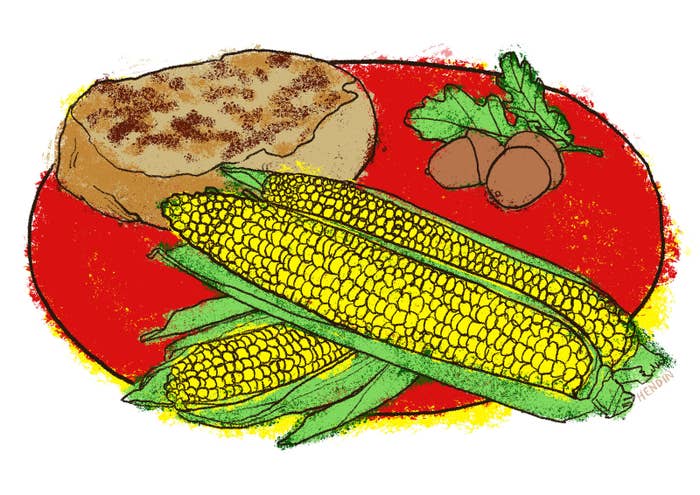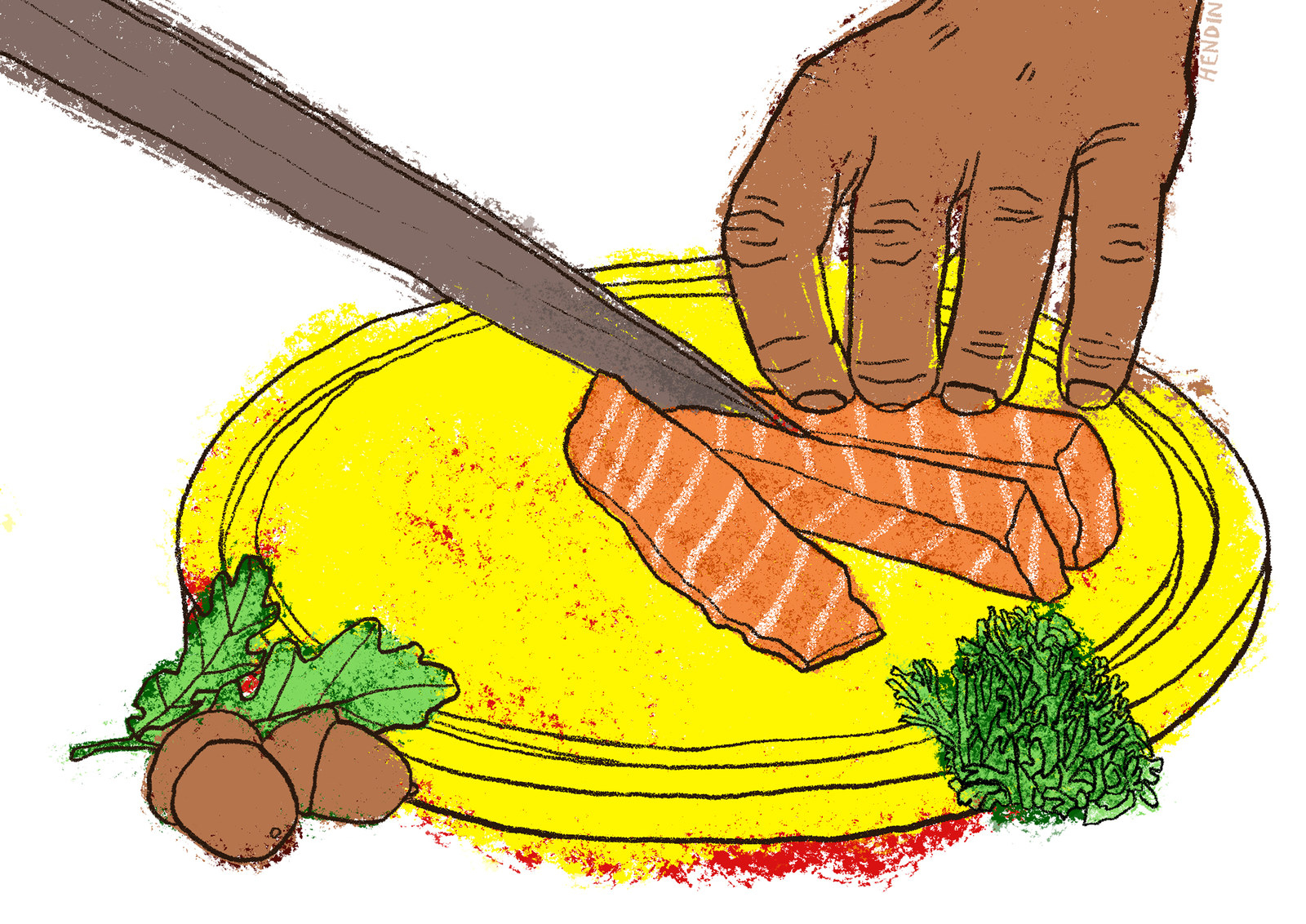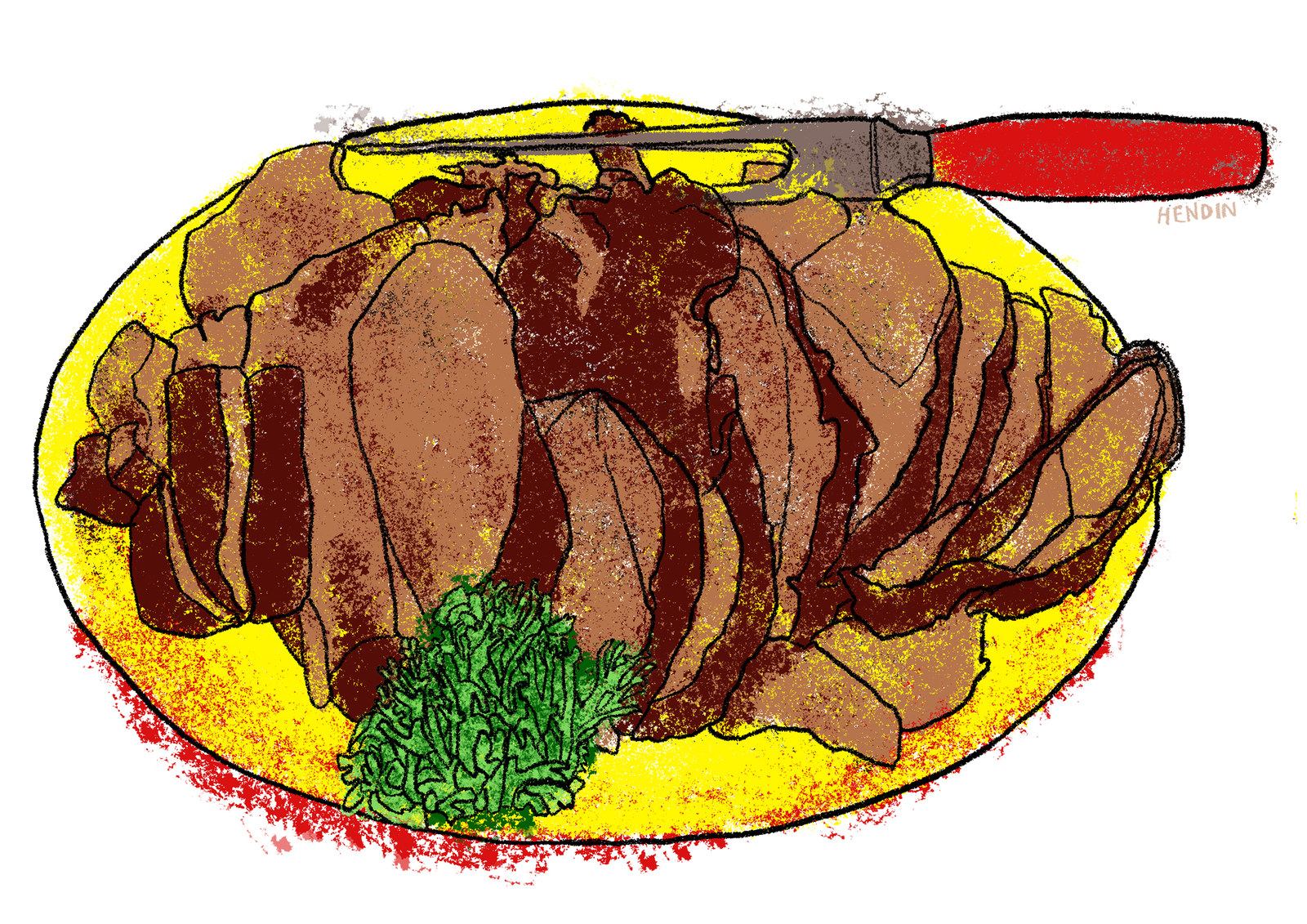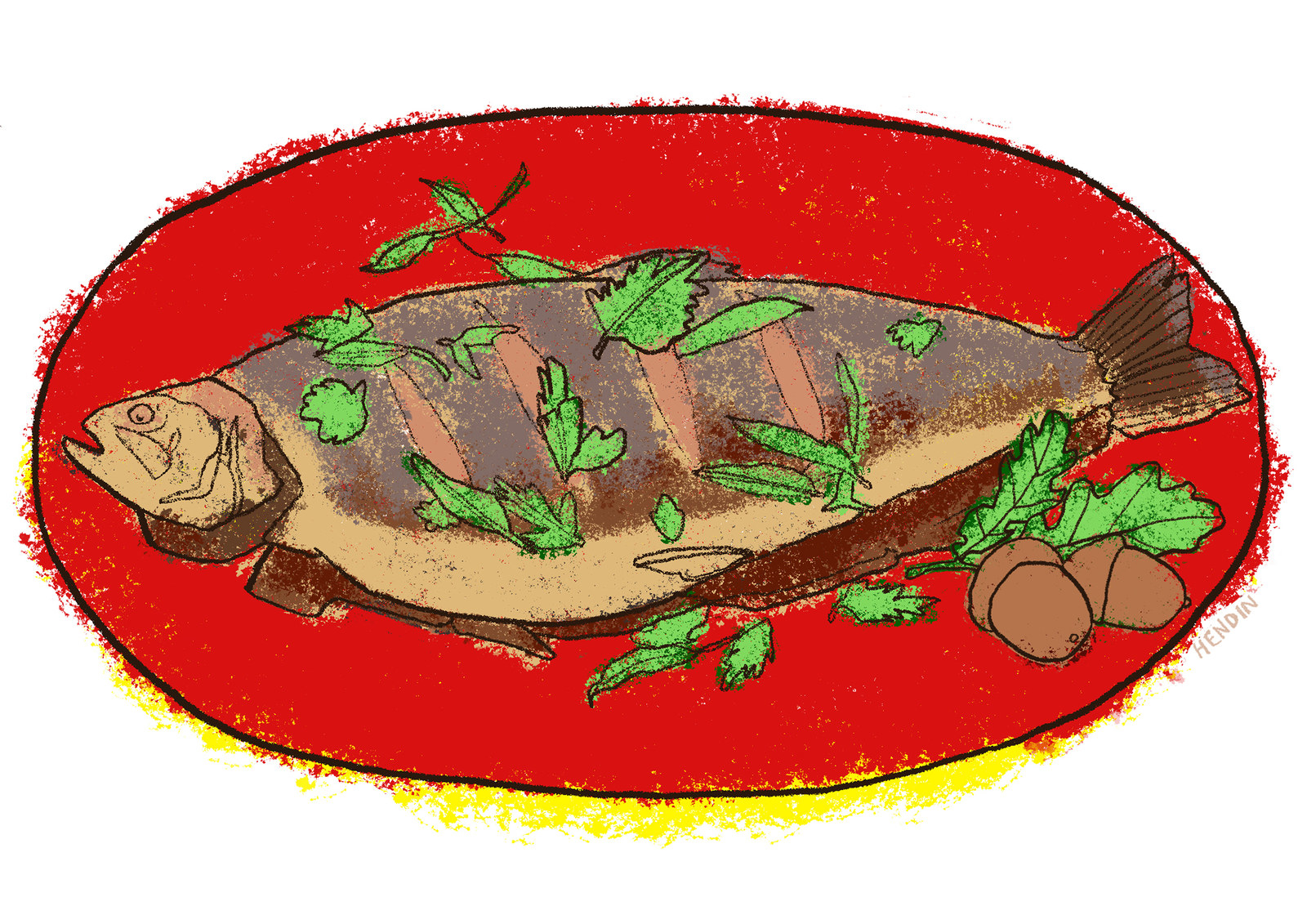Chef Rich Francis is Haudenosaunee on his mother’s side, Gwich’in on his father’s. His family’s food was native to this land before it was even called Canada. “For me, as a First Nations chef, it’s really hard to digest that whole trendy concept of ‘nose to tail,’” Francis says, astounded about the recent novelty of restaurants using every part of the animal. “I don’t know any other way.”
In precolonial times, the Gwich’in were semi-nomadic, tied to the caribou, following their seasonal migration. Beginning in the fall, they’d hunt. The animal provided them with a host of resources and ceremonies: hides for clothing, antlers for medicine or tools, and meat that would feed at least 20.
“The Elders would get the best part of the animals, the tenderloin or even the head,” Francis says. “My dad told me there was a way of tenderizing the meat using the stomach contents, like a rub or marinade. The acid makes sense from a chef perspective. But how do you market something like that?”
While it’s hard to imagine “bile-marinated ribs” on a restaurant menu, the ambitious Francis, a finalist on Season 4 of Top Chef Canada, would ideally find an approach between originalist and modernist, while respecting a food tradition that sees everything on the plate as having more connection than just flavour harmony. “Storytelling is a huge aspect of Aboriginal culture, and food is no exception. It has to have a sense of community and direction.”
To tell that story, he suggests searing the caribou meat, wrapping it in caribou moss (which grows on the tundra) before tossing it onto the fire, and serving it with cloudberries. “That tundra is basically the caribou’s diet. So there’s that sense of community in what you’re serving. I love fire and hate modernist cuisine.”
But he can’t do any of that. Not legally, at least, in a restaurant in any large Canadian city outside of St. John’s, Newfoundland, the only province where licenses can be issued to serve hunted meat outside of a special event. That’s just one of the reasons why the the Indigenous cuisines of Canada are all but absent from our burgeoning restaurant scene.

If there is such a thing as “Canadian food,” it belongs to Indigenous peoples, communities that farmed, hunted, fished, preserved, and cooked long before the French showed up with their mother sauces and names for different-sized cubed vegetables. In 2009, when prime minister Stephen Harper hosted a lunch for US president Barack Obama, his chef Oliver Bartsch created a Canadiana menu that included miso-cured Nunavut Arctic char, smoked bison, and pot de crème made from Saugeen First Nation yogurt. When was the last time a non-president saw those on a restaurant menu?
Canada, with its multiethnic, multinational population influencing its culture in a variety of ways, has an increasingly respected dining scene.
For the past decade, I’ve been focussed on food as a writer, and before that, as a professional cook. The question of “what is Canadian food?” comes up regularly. When the New York Times travels to our cities to write about our food, it touts multiculturalism as the backbone of our cuisine. And that’s the narrative we’re happy to push. But it’s because we’ve paved over our history. A lot happened before this era of everyone loving everyone else’s food. And yet Indigenous food practices are rare in our dining scene.
Full disclosure: I’m a white guy. As a Jew, I grew up on beef salami on rye bread. As a food writer and former cook, I’ve had the privilege of using food to connect with and learn from a much larger variety of cultures than those I grew up with. I’ve been pretty ignorant of Indigenous peoples. But I’ve begun to learn about their way of life — in which hunting, harvesting and preparing food, and a relationship with the environment are central to culture — by looking through the lens of their cuisines.
For all the celebrating Canadians do for our diversity and our constantly expanding food culture, Indigenous peoples, who make up 5.6% of the population, are represented in less than 1% of the 91,300 restaurants. There are more than 1.8 million people in Canada who identify as Aboriginal (this includes First Nations, Métis, and Inuit). The country has no more than a handful of Indigenous restaurants — Painted Pony Cafe, Salmon n’ Bannock, and Songhees Seafood & Steam in British Columbia, Native Delights in Alberta, Bannock Express in Saskatchewan, Feast Cafe Bistro in Manitoba, Le Traite in Quebec. There’s only one in Toronto, Tea n Bannock, but Salmon n’ Bannock owner Inez Cook doesn’t count it because the owner isn’t Indigenous. Compare that to Vietnamese restaurants, a ubiquitous staple of Canadian cities. The total Vietnamese population in Canada is 220,425.
The absence of Canada’s original cuisines from our restaurant culture is a story of colonialism, about cultures and their food traditions driven to near extinction at the same moment that others were experiencing a shift to commercialization. It begins with the expansion into North America by Europeans.
Every chef I’ve ever met is inspired by trying methods that are new to them, by understanding where food comes from, by anything that is delicious. There’s no reluctance on their part to celebrate Canada’s culinary history. But there is a huge gap in knowledge that, in other cuisines, is filled with written documentation. The disappearance of Canada’s original cuisines isn't just about a lack of cookbooks, or practices that are considered illegal — it's also about the colonialism that shaped our society. It’s about a culture, and its food practices, that was systematically dismantled at the same moment in history when the commercial restaurant industry was being birthed.

“There are a lot of systemic issues that are involved around why there’s been so much disconnect with our food and the people of Canada,” Francis says. “The cultural genocide. The residential schools. And colonialism. A lot of our practices were taken away. They were lost.”
The 17th-century French colonizers of North America, lacking the numbers to dominate through conquest, forged strong alliances with many nations — Mi'kmaq, Huron, Cree, and a dozen others — by trading gifts in exchange for military aid and furs. This was not a bond of mutual respect, but a racist strategy from the French, who referred to the natives as “savages” or “children,” to be tamed over time. Trading with colonizers was a deal that started badly and got worse very fast.
“One of the first things that happened is the animals they hunted were depleted by the fur trade,” says professor Jarvis Brownlie, who teaches about the history of Aboriginal rights at the University of Manitoba. “Basically, the fur trade was a commercialization of hunting. And it was unsustainable from the beginning. That led to lots of changes, including adopting flour into their diet.”
The 1763 defeat of the French at the hands of the English nullified these trading alliances. In 1830, the English adopted a policy of conversion for Indigenous peoples. Lands were negotiated in bad faith through legal documents that the native population had no means of truly understanding.

“The provinces all introduced game laws that basically criminalized Aboriginal hunting,” says Brownlie. “It was just after the treaties, which was ironic, because in all the treaty negotiations, they promised them that they’d still be able to hunt. But they’d include bag limits and closed seasons, which meant you could only hunt a few weeks of the year. Well, if you live off hunting, that’s a terrifying reality to face.”
As a part of the Indian Act in 1884, the federal government banned the potlatch, a multiday social event practiced by Northwest Coast peoples (Nuu-chah-nulth and Kwakwaka'wakw among them) where the community gathered to determine a variety of business — eating, drinking, anointing new leadership, marrying, and distributing wealth.
“Missionaries especially pushed for the ban,” says Brownlie. “The underlying reasons included the fact that potlatches were the central cultural institution of these societies and thus helped maintain their cultures, and then also the fact that they led to large gatherings, which were threatening in the eyes of the settlers.”
Later, in an 1895 amendment to the Indian Act, the potlatch ban was revised to be more effective, along with a ban on the Sun Dance of the Lakota, Blackfoot, Blood, Piegan, and the Plains Cree. “The first law that banned the potlatch, the judge said, ‘I don’t know what you’re banning,’” says Brownlie. “Then they rewrote it to say they were banning any festival that involved the giving or taking of gifts, and it was very difficult to write it in such a way that they weren’t also banning Christmas.”
With the goal of assimilation, many Indigenous peoples were forced to practice agriculture, their children made to attend boarding schools run by missionaries. The schools, where Indigenous languages were forbidden, were eventually revealed to be rife with physical, sexual, and psychological abuse. These schools remained open until 1996.
The change in lifestyle from semi-nomadic to agrarian, on top of the ravages of European diseases and alcohol, the abduction and abuse of children into the residential schools, failed in the goal of assimilation. But it succeeded in decimating Indigenous cultures, cutting the people off from their food source as hunters, and driving many Indigenous languages to the brink of extinction.
“Our connection to the land has always dictated where we go, our culture and history."
“Our connection to the land has always dictated where we go, our culture and history,” says Francis, who has been meeting and learning about different food customs from Indigenous peoples across Canada for a television show, with plans to incorporate the ideas into an upcoming restaurant.
Despite the Humane Society’s approval for substinance sealing, the historic tradition has garnered near-universal condemnation from animal rights groups. A 2009 ban on seal imports by the European Union shrunk the market for pelts, shunting the price from as high as $105 (CAD) to as low as $15.
“Our traditional seal hunts have become something so black and white. These are traditions that have sustained us in almost unlivable conditions,” Francis says. “The creator has given these things to us to use. And we only take what’s needed. It’s just about keeping that cycle going.”
Even without objections from animal rights groups, just serving hunted animals in restaurants is nearly impossible. Food safety and inspection laws prevent this key element from translating to a commercial venue. Only Newfoundland and Labrador allows game meat to be served in licensed restaurants. In 2014, Quebec experimented with a pilot program allowing a handful of famous chefs to serve game meats — muskrat, hare, deer, beaver, and squirrel — on their menus. But for the most part, in a Canadian restaurant, you can’t cook animals you’ve hunted.
“There are a lot of hurdles in major cities, where I know that a restaurant like mine would thrive and succeed,” Francis says. “I’m having to accustom my food to the rules and regulations of today, which kind of wipes out everything. It would be virtually impossible to practice some of these food customs of my people, to take my restaurant to Toronto and show the things that were meant to be enjoyed as they are. I’m forced to bring it to these reserves, and not a lot of people go there.”
While continuing to plan a formal restaurant, Francis has been cooking at pop-ups and private events, venues that allow him to skirt the laws concerning hunted meats.
“I think there needs to be some kind of leniency in terms of the cultural stuff, for First Nations chefs and artists, to be able to now express ourselves freely. We need some legal changes, some exceptions to the rule. Otherwise, you have to do it illegally.”

Another route, practiced by chefs like Marie-Cecile “Cezin” Nottaway, is to disregard these laws. “I’ll serve wild meat. I’m practicing my traditions. And if I get in trouble, I get in trouble,” says Nottaway, who hunts and fishes and is proud to serve what she catches (or buys from local hunters) through her business, Wawatay Catering. “I’ve actually served wild meat to former Prime Minister [(Joe Clark]), to the former governor general [(Michaëlle Jean]). No one’s ever complained. No one’s ever asked questions. No one’s ever gotten sick.” Nottaway’s kitchen is on Kitigan Zibi reserve near Maniwaki, Quebec, near Ottawa. She’s hunted beaver, muskrat, rabbit, partridge, and fish, and served them all at catering events in Ottawa, where she does the majority of her business. Nottaway is aware that her position isn’t legal. But she would rather be cooking a sincere version of her Algonquin family’s food, directly from the land.
“This is what I do. I would rather serve that meat than the chicken, pigs, and beef that are fed chemicals. Why are we allowed to eat something that’s so processed and full of chemicals? But we’re not allowed to eat what’s from Mother Nature, straight off the land?” Nottaway says. “My ancestors lived off that food. Why not other people? Why take that away from me, again?”
“It is hard not to notice that among all of the mixing of culinary cultures across Canada, to the point of creolization in places, one group is largely missing,” writes Lenore Newman in her book, Speaking in Cod Tongues: A Canadian Culinary Journey. “The culinary voices of Indigenous Canadians have been tragically silenced for most of Canada’s history. Their cuisine is a founding element of of Canada’s culinary identity, but it is usually unacknowledged.”
Modern restaurants grew out of Paris in the late 18th century. By 1876, new technologies — refrigeration, gas stoves, measuring spoons — were changing the way food was cooked and sold. And while enterprising immigrants promoted new culinary trends — hamburgers, pizza, ice cream cones — that grabbed hold of North Americans' fascination, the Canadian government was herding Indigenous children into residential schools. During the period when restaurant culture was integrating with our way of life, Indigenous ways of life were being stomped out. “Our food was a part of our way of life,” Francis says. “We weren’t allowed to use our language. Our food was not allowed.”

Disappointed that she couldn’t find her own cuisine in her own city, Inez Cook decided to make it herself. “In Vancouver, we have Ethiopian food, Afghanistan food, sushi, Italian, Chinese. But we’re the only First Nations restaurant in the city. That’s crazy. It’s so hard to find food from the land here.”
Cook’s solution, in 2010, was to open her own restaurant in Vancouver, Salmon n’ Bannock. But acquiring farmed versions of game meats — elk, bison, caribou — in the city can be expensive. “My supplier had one little portion of caribou. We sold out in the first couple days,” she says. “But it was ridiculously expensive. The deer available from our suppliers was from New Zealand; that goes against everything we’re doing.”
She says a lot of her customers are from nearby reserves, visiting Vancouver for access to hospitals. And that same distance from the potential clientele is an obstacle for entrepreneurship. “A lot of the First Nations communities are not in urban areas. To go to an urban area, you’d have to leave your family, your culture, and everything to go open a restaurant in an expensive city.”
Entrepreneurship requires investment. And while restaurant employment has a lower barrier to entry than other skilled labour, just moving to an urban centre is an obstacle for many. “I think poverty is one of the biggest factors,” says Christa Bruneau-Guenther, the owner of Feast Cafe Bistro in Winnipeg, Manitoba. “We have third-world conditions in our northern communities. A lot of these families are living 20 people in a one-bedroom home. Some of them don’t have running water, don’t have flushing toilets. Their land is barren. There are so many reservations that can’t even plant gardens.”
That poverty, says Bruneau-Guenther, obstructs entry to the big-city kitchen workforce. “You have these people up in the northern communities that have no jobs, that come to the big cities with no family, nowhere to go. They go onto social assistance. And then they’re on the street and trying to survive. And then you’re dealing with teen pregnancy and violence. That’s just kind of the reality of our people.”
Beyond the representation in restaurants, there is the misplaced value we place on foods based on nationality, rather than the labour and difficulty involved. There's an economic racism at the root of the divide between all European and all non-European cuisines. It's only in the last decade that North Americans have exalted Asian cuisines such as Chinese and Korean, beginning to raise them from “cheap and cheerful” to esteemed. The general public is still willing to pay twice as much for handmade Italian noodles as they would for Chinese noodles.
“We can see the patterns clearly when we consider price of a meal as a proxy for prestige and value,” says Krishnendu Ray, associate professor of food studies at New York University. “The cuisines of ultimate racialized others — Native Africans and African-Americans — are erased or devalued, while the cuisines of various immigrant groups are evaluated through a complex matrix of class, race, and gender.”

As research for his recent book, The Ethnic Restaurateur, Ray studied menu prices in New York and found a huge disparity between average cheque sizes (meal for one, with wine and tip) at French ($66.45) or Japanese ($68.94) versus Mexican ($40.41) or Thai ($32.50) restaurants. “With a few exceptions, the more powerful or rich a nation state, and more affluent its emigrants, data shows greater likelihood of more expensive cuisine.”
Many of these cuisines are going through a transformation right now. We’re starting to see more and more midrange restaurants serving Mexican, Thai, and Korean with formal service, charging the $25 per entree that the labour deserves — rejecting the prejudiced notion that they should be cheap.
These cuisines are part of communities in their third or fifth generations in America/Canada. They are nurtured, developed, and promoted by populations with disposable incomes, no longer that first wave of immigrants who had to work in restaurants or drive cabs, accepting whatever “the market” would pay for their cuisine. That’s a familiar narrative: people coming here with nothing, working hard, enduring institutional racism, and ultimately thriving, their cuisine embraced as popular, just before white people copy and sell it for more money.
The natural path of immigrant populations — to escape persecution in their countries, to go from working poor to business owners in a couple generations — doesn’t work when you’re from here and it’s the Canadian government that has persecuted you.
We’re also talking about a mosaic, rather than a homogeneity. There is no one “Indigenous cuisine” any more than there is an “Asian cuisine.” Canada is a big place. The first peoples to live on the land that became Canada existed in vastly different environments, with access to vastly different ingredients: salmon on the coast, buffalo on the plains, pickerel near the lakes, and so on.
“The thing we all have in common is the bannock,” Nottaway says. “But it’s the stuff that we were given when we had our rights taken away, to hunt, to fish, to live off the land.” She sees the fried flatbread as a curse imposed by colonists, the milled flour a “gift” in exchange for the theft of hunting and fishing rights. She’ll cook bannock, but she wants people to know it doesn’t represent her true heritage. “I find, all across the Anishinaabe nation, one we have in common is misrepresentation.”

It may be a semantic distinction to some, the difference between welcome and unwelcome culinary influence. Newman presents this as the conflict between creole and fusion. “Understanding creoles begins with what they are not: Fusion foods,” writes Newman. “When groups with distinct identities live together for a long time, something else emerges, something more lasting. The term we use for this mixing is ‘creole,’ from the Latin word meaning ‘to create.’ A cuisine becomes a creole once mixing is so established that a generation of people is born into it.”
So much of this story is lost due to another factor, instrumental in the erasure of culture: the absence of written language as a tool of preservation compounded by the persecution of oral history traditions.
There were about 50 different languages spoken here before it became known as Canada, explains the University of Ottawa’s Site for Language Management in Canada, listing dozens of dialects spoken across the country.
But these were all spoken languages, not written. The oral traditions — stories, beliefs, instructions passed on verbally — meant that without a written language to preserve such things, the impact of colonization was much larger.
"Our food memories are still very much alive."
“There was a knowledge gap,” says Francis. “But our bloodlines are still there. Our food memories are still very much alive. We’re reclaiming our own voice, not only with food, but also music and arts. I’m using our food as a vehicle for truth and reconciliation. I’m doing that by going back to the people who still carry these food traditions from region to region.”
Because his culture was systematically eradicated (while others were being commercialized), with no written documents to preserve those traditions, Francis has been traveling among First Nations communities, learning specific food customs from Elders who remember them. “A lot of our food is rooted in ceremony, customs, and traditions you’ll never find in a cookbook. Our food comes from our connection to the land. Modern Indigenous cuisine, for me, is really rooted in our teachings. It’s a cuisine based on principles, from our teachings of the medicine wheel. Everything as a community.”
Compelled to maintain and share his traditions — cooking with caribou, flavouring with sage, cedar, sweetgrass, and tobacco, plus methods and ingredients pulled from other Indigenous cuisines — Francis has given up plans to open his 7th Fire restaurant on a reserve in southwest Ontario, relocating the concept to Saskatoon’s financial district. “It’s the town where I can do something and then apologize for it later,” he said. “I don’t want to colonize my point of view again, on a plate. I need it to be as authentic as possible. And legal.”
The culinary future he sees is a tenuous balance between appealing to a large, urban audience, which pushing back against its regulations.
“I can’t serve whale or seal. I’m not trying to break rules. I might bend a few. But it’s something I’m willing to do in order to get my vision out there.”
Corey Mintz is a food writer and columnist for the Globe & Mail, focusing on the intersection of food with politics, farming, labour, ethics, and culture.
Ossie Michelin, a freelance journalist and proud Labradorian, was a contributing editor on this story.
